KhalifaSat
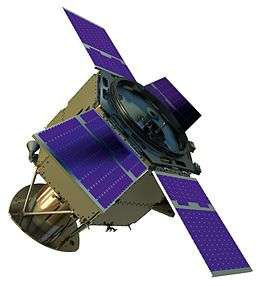 Artist's impression of KhalifaSat | |
| Mission type | Remote sensing |
|---|---|
| Operator | MBRSC |
| Mission duration | 5 years |
| Spacecraft properties | |
| Bus | SI-300 |
| Manufacturer | Mohammed bin Rashid Space Centre |
| Dry mass | ~300 kilograms (660 lb) |
| Power | 450W @ EOL |
| Start of mission | |
| Launch date | 29 October 2018 |
| Rocket | H-IIA 202 |
| Launch site | Tanegashima Yoshinobu 1 |
| Contractor | Mitsubishi Heavy Industries |
| Orbital parameters | |
| Reference system | Geocentric |
| Regime | Sun-synchronous orbit |
| Epoch | Planned |
| Main camera | |
| Name | HiRAIS |
| Type | Pushbroom Camera |
KhalifaSat is a remote sensing Earth observation satellite that is being manufactured in the United Arab Emirates at the Mohammed bin Rashid Space Centre (MBRSC)[1]. It is the first satellite to be built in the clean rooms of the Dubai government’s space science and research facility and the first to be developed entirely by a team of Emirati engineers.[2]
The Mohammed bin Rashid Space Centre is a Dubai government based space centre working on the National Space programme.[3] MBRSC already has two Earth observation satellites in orbit, DubaiSat-1 and DubaiSat-2, which were built in partnership with Satrec Initiative, a South Korean satellite manufacturer.[4] With the knowledge gained through this co-operation, MBRSC engineers are now designing and developing KhalifaSat in the UAE without assistance.
The project was officially announced by His Highness Sheikh Mohammed bin Rashid Al Maktoum, Vice President and Prime Minister of the United Arab Emirates (UAE), and Ruler of Dubai, in December 2013.[5] The manufacture of KhalifaSat began in South Korea at Satrec Initiative’s facilities. A team of Emirati engineers used the facilities there while the Advanced Technology Laboratories at MBRSC were under construction. In early 2015, the project was moved to MBRSC where every aspect of its development has continued[6]
Objectives & national importance
KhalifaSat will provide high-resolution imagery of Earth to be used for various purposes, including urban planning, change monitoring, area classification, monitoring environmental change and aiding relief efforts for natural disasters[7] The satellite imagery from KhalifaSat will be provided to local government entities and a number of commercial entities both locally and internationally.[8]
The manufacture of KhalifaSat at MBRSC also aims to help diversify career paths for young Emiratis, along with creating a legacy for the satellite industry in UAE[9]
Technical insights

KhalifaSat is hexagonal in shape with four deployable solar panels. The satellite bus comprises three decks and also an upper sun shield, which will protect the camera from temperature fluctuations and radiation. The solar panels are attached to the sides of the satellite bus structure, the frame of which is manufactured from longerons and rails.[10]
| Features | Technical Specifications |
|---|---|
| Orbit | Sun-synchronous orbit, nominal altitude - 613 km Inclination - 98.13º |
| Spacecraft Mass | 330 kg |
| Power Generated | 450W @ EOL |
| Mass Storage SSR (Solid State Recorder) | 512 Gbit |
| Planned Mission Lifespan | 5 years |
The satellite shell is just under two metres in height and less than 1.5 metres in diameter. The total mass of the spacecraft is estimated to be around 330 kg. The most sensitive component in the satellite is its Camera System (KHCS). This will be covered with a Carbon Fibre Reinforced Polymer (CFRP) sun shield to protect it against harmful radiation.[11]
KhalifaSat contains an advanced positioning technique that allows the capture of a large number of 3D images at once with greater accuracy and quick response.[12]
KhalifaSat camera system (KHCS)
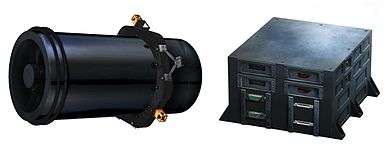
The primary payload on the satellite is the KhalifaSat Camera System, which is compact and lightweight. It includes three main subsystems: the Electro-Optical Subsystem (EOS), the Image Transmission Unit (ITU) and the Solid State Recorder (SSR).[13]
| Instrument Type | Pushbroom imager |
| Instrument Mass | 70 kg |
| Power Consumption | 168W |
| Downlink Data Transmission Speed | 320 Mbit/s |
| Detector | TDI |
The pushbroom camera has a 0.7m Ground Sampling Distance (GSD) for panchromatic imagery and 2.98m GSD in four multi-spectral bands. The multi-spectral capabilities of KhalifaSat include four channels in both the visible and near infrared spectral ranges (Red, Green, Blue, and NIR) with a radiometric resolution of 10 bits.
The camera system also includes a Korsch telescope, comprising a three-mirror configuration that provides the widest possible field of view and reduces optical irregularities.[14]
Imaging modes
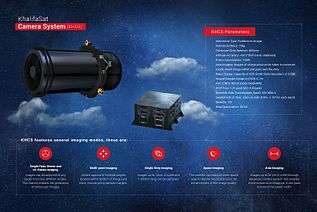
The advanced camera system of KhalifaSat features several imaging modes:
Single Pass Stereo and tri-Stereo Imaging -Images can be acquired of any target from two different angles. This feature enables the generation of stereo pair images.
Multi-point Imaging - Allows capture of multiple targets located within 600 km of the ground track, manoeuvring between targets.
Single Strip Imaging - Images up to 12 km in width and 1,500 km long can be captured
Space Imaging – The satellite can point to outer space objects like the Moon and stars for enhancement of the image quality
Area Imaging - Images up to 36 km in width through advanced control system that enables three consecutive imaging in one pass to extend the swath width
Critical design review
In January 2016, MBRSC announced that the final design completion of the engineering model of KhalifaSat had passed the Critical Design Review (CDR). This also included the approval of the proposed software and systems that will be part of the satellite. Following the successful CDR the team is now working on KhalifaSat’s flight model [15]
Launch window
MBRSC has an agreement with Mitsubishi Heavy Industries Ltd (MHI) for the launch of KhalifaSat to take place in Japan. The launch vehicle will be the H-IIA rocket and is scheduled to launch in 2018, before placing KhalifaSat into a Low Earth Orbit[16]
Ground control
The MBRSC ground station in Dubai, UAE, will support KhalifaSat and its functions from Earth. The ground system includes three main subsystems: the Antenna and Radio Frequency (RF) subsystem, Mission Control Station (MCS), and Image Receiving and Processing Station (IRPS).
The main function of the Antenna & RF subsystem is to transmit imaging orders, give commands to the satellite, receive information and download images through the X-band feed. The MCS plans and operates the entire mission. This includes the configuration and scheduling of resources for both space and ground elements.
The IRPS provides real-time receiving and processing of downlink data. It also generates standard image products and catalogues, manages archives, and interfaces with client IRPS [17]
Team
The KhalifaSat team is made up entirely of United Arab Emirates nationals. This is the first time a satellite project has been designed and developed by Emiratis.[18]
- KhalifaSat - Important Milestones
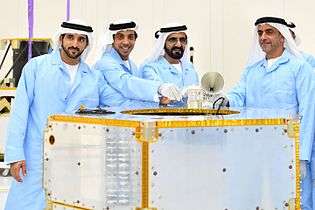 HH Sheikh Mohammed bin Rashid, the Vice President & Prime Minister of the UAE placed the first component on chassis of KhalifaSat - Nov 2016
HH Sheikh Mohammed bin Rashid, the Vice President & Prime Minister of the UAE placed the first component on chassis of KhalifaSat - Nov 2016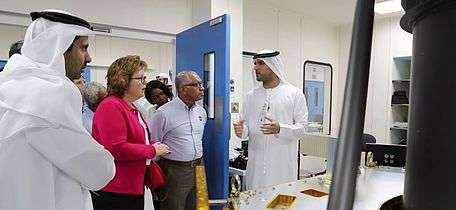 NASA's Chairman, Charles Bolden, was briefed about the KhalifaSat development during his visit to Mohammed bin Rashid Space Centre (MBRSC) - June 2016
NASA's Chairman, Charles Bolden, was briefed about the KhalifaSat development during his visit to Mohammed bin Rashid Space Centre (MBRSC) - June 2016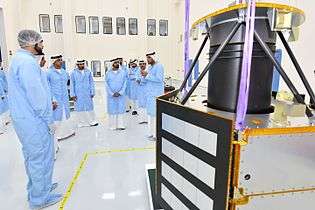 HH Sheikh Mohammed bin Rashid Al Maktoum was briefed on the progress of KhalifaSat's development by Amer Al Sayegh - Nov 2016
HH Sheikh Mohammed bin Rashid Al Maktoum was briefed on the progress of KhalifaSat's development by Amer Al Sayegh - Nov 2016
References
- ↑ "KhalifaSat-type-of-satellite".
- ↑ "khalifasat--developed-by-emirati-engineers".
- ↑ "MBRSC is a Dubai government space entity".
- ↑ "khalifaSat-UAE-advanced-satellite-the-journey".
- ↑ "dubai-ruler-reaches-for-the-stars-with-first-emirati-manufactured-satellite".
- ↑ "uae-satellite-plant-to-be-finished-in-months".
- ↑ "About-khalifaSat-earth-observation-satellite".
- ↑ "Khalifasat-high-resolution-satellite-imagery-services".
- ↑ "khalifasat-career-opportunities".
- ↑ "technical-specificatons-of-khalifasat".
- ↑ "technical-specifications-of-khalifasat-website".
- ↑ "Mohammed-bin-Rashid-Space-Centre-announces-10-innovative-space-technologies-satellite-applications".
- ↑ "khalifasat-camera-system-technical-specifications".
- ↑ "what-is-khalifasat-camera-system-all-about".
- ↑ "First-indigenous-uae-satellite-khalifasat-closer-to-launch".
- ↑ "khalifasat-earth-observation-satellite-to-be-launched-on-H-IIA-rocket".
- ↑ "Ground-station-for-khalifasat-the-uae-remote-sensing-earth-observation-satellite".
- ↑ "The-team-of-emirati-engineers-working-khalifasat".